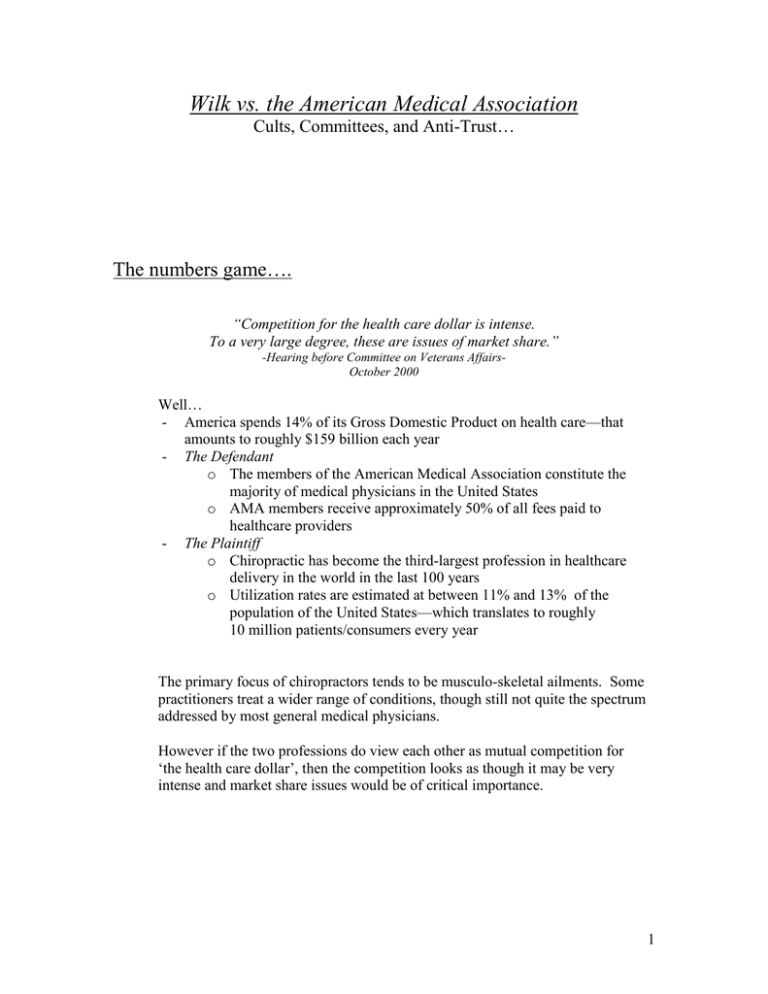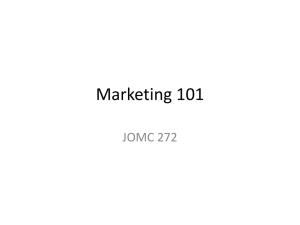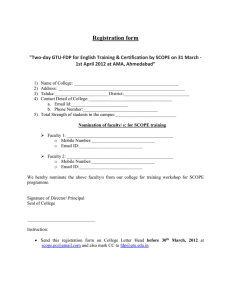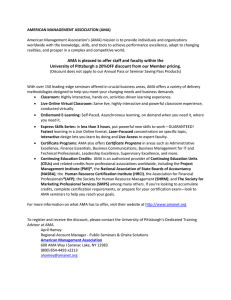Wilk vs. the American Medical Association
advertisement

Wilk vs. the American Medical Association Cults, Committees, and Anti-Trust… The numbers game…. “Competition for the health care dollar is intense. To a very large degree, these are issues of market share.” -Hearing before Committee on Veterans AffairsOctober 2000 Well… - America spends 14% of its Gross Domestic Product on health care—that amounts to roughly $159 billion each year - The Defendant o The members of the American Medical Association constitute the majority of medical physicians in the United States o AMA members receive approximately 50% of all fees paid to healthcare providers - The Plaintiff o Chiropractic has become the third-largest profession in healthcare delivery in the world in the last 100 years o Utilization rates are estimated at between 11% and 13% of the population of the United States—which translates to roughly 10 million patients/consumers every year The primary focus of chiropractors tends to be musculo-skeletal ailments. Some practitioners treat a wider range of conditions, though still not quite the spectrum addressed by most general medical physicians. However if the two professions do view each other as mutual competition for ‘the health care dollar’, then the competition looks as though it may be very intense and market share issues would be of critical importance. 1 The Suit… On October 13th, 1976 four chiropractors sued the American Medical Association (the AMA) alleging that the organization had systematically conspired to keep chiropractors out of the health care market. The suit also charged The American College of Surgeons, The American College of Radiology, The Joint Committee on Accreditation of Hospitals, The American College of Physicians, The American Academy of Orthopedic Surgeons, and Dr. James H. Sammons—an AMA official—with participating in the conspiracy. Later on, of the original six additional defendants, all but the American College of Surgeons and the American College of Radiology were dismissed. The Litigation would last 14 years in total. The AMA claimed it acted out of what it believed to be the best interest of patients while the chiropractors insisted the AMA had acted solely for the purposes of preserving a monopolistic hold on the health care market. Setting the legal stage… - - - - - Prior to 1975 it was commonly agreed in the legal community that anti-trust laws such as the Sherman Act and the Clayton Act were intended to regulate professions involved in “trade or commerce” and did not apply to “learned professions”, including the health profession… this would change with two important cases In 1975 the Supreme Court ruled against the Virginia State Bar Association’s establishment of a minimum fee schedule under the Sherman Act o The Bar was attempting to engage in an activity that was patently anticompetitive and counting on a sweeping exclusion of their profession from prosecution Three years later this precedent would be reinforced and broadened when the Supreme Court also ruled against the National Society of Engineers o Here the Society claimed its actions should be exempt from prosecution because it believed itself to be acting on behalf of its own reputation and public safety—the Court disagreed These two cases encouraged the Federal Trade Commission to vigorously enforce anti-trust regulations within the health field, prosecuting most notably the American Medical Association multiple times as well as the Michigan State Medical Society, the Indiana Federation of Dentists, and the Forbes Health System Medical Staff The legal precedent would be critical to this case—the sweeping exemption of health care professions from prosecution for anti-competitive practices had been eliminated (Feldstein, Paul. Health Economics) 2 The Sherman Anti-Trust Act—not just for Standard Oil anymore Sherman Act--§ 1. Trusts, etc. in restraint of trade illegal; penalty Every contract, combination in the form of trust or otherwise, or conspiracy in restraint or trade or commerce among the several States, or with foreign nations, is declared to be illegal. Every person who shall make any contract or engage in any combination or conspiracy hereby declared to be illegal shall be deemed guilty or a felony, and, on conviction thereof, shall be declared punished by fine not exceeding $10,000,000 if a corporation, or, if any other person, $350,000 or by imprisonment not exceeding three years, or by both said punishments, in the discretion of the court. Using the Sherman Act—2 methods of application Anti-competitive behavior may be declared unlawful under the Sherman Act on either per se grounds or according to a rule of reason. Per se grounds Price fixing, economic boycotts, tying arrangements, and division of horizontal markets are per se violations—they are activities that are clearly anti-competitive and their subsequent effects are irrefutably harmful to consumers. The rule of reason Attempts to determine whether harm caused by an anticompetitive practice outweighs the benefits of excluding an activity. More succinctly, it determines whether an action promotes or restrains competition. A determination under rule of reason hinges on the market power a particular firm or organization wields. An organization without specific market power would not be able to effect significant detriment, regardless of the course of action it pursued 3 Determining the market power of the AMA… Using an elementary definition of market power—the ability of raise prices above the competitive level by restriction output—the first critical step to the case was to determine whether the AMA had sufficient market power in the health services market to cause significant damage to competition o The finding of the district court, which was later used by the circuit court during the appeal, was supported by several determinations: The AMA’s members constituted a substantial force in the provision of health care services as well as a majority of medical physicians AMA members received a greater portion of fees paid to physicians than were paid to non-AMA members Evidence showed that AMA members received approximately 50% of all fees paid to health care providers Other methods of determination o Other methods of determination have also been implemented, mainly in response to a more recent hypothesis that the AMA is partially responsible for rising healthcare costs In an investigative article, Barry Seldon, Chulho Jung, and Robert Cavazoz employed the Bresnahan method and, using a statistical estimation of a supply relationship—a supply function if the industry acts competitively—employed data from the AMA and other sources from 1983 to 1991 to ascertain a level of market power held by the AMA They concluded that price is maintained above marginal cost in the market of doctors’ services, suggesting the existence of market power Figure 1: Monopoly or Oligopoly 4 Still more evidence… - A final observation about market power is that they may still be a shortage of physicians in the United States though some maintain there is a glut o A wait of days or weeks to see a physician with an appointment as well as long wait times spent on office waiting rooms is indicative of demand exceeding supply, rather than the other way around Note, the only evidence used in the actual court decision were the first three determinations used in the district court case. I only mention the subsequent evidence because I was surprised by the court’s willingness to make decisions without more decisive evidence. The later evidence comes from articles and studies I found later while attempting to find evidence to counter the court’s determination. The AMA Campaign… Committees, Labels, and Principles - - - - According to Judge Getzendanner—the appellate court judge who reviewed the 1981 jury decision in 1987—the AMA began a campaign in the early 1960s to “contain and eliminate” the chiropractic profession out of concern that medical doctors were cooperating with chiropractors The judge explained that the Association formed Committee on Quackery in 1963 with the specific purpose of the Committee being an attempt to eradicate chiropractic as a competitor Three years later the Committee passed a resolution labeling chiropractic and “unscientific cult” o The label of “unscientific” automatically invoked Principle 3 of the American Medical Association’s Principles of Medical Ethics, which bars any physicians from professionally associating with practitioners of an unscientific profession. o The action effectively constituted a boycott of chiropractic, which lasted formally until 1980. Additionally the Association was found to have regularly communicated with medical boards and associations to inform them that professional association between physicians and chiropractors was unethical Standard X - In 1973 the AMA also drafted “Standard X”, which integrated the bar into the Joint Committee on Accreditation of Hospitals accreditations standards The Standard, said to be adopted at the urging of the AMA, interfered with the ability of chiropractors to make use of hospital resources such as radiology and other diagnostic services o This not only impaired professional interaction with hospitals but also served to raise costs for chiropractors by blocking access to more inexpensive resources 5 Backing down over time… - - The AMA appeared to have backed down somewhat from the rigorous nature of the initial campaign, though it was never entirely clear why In 1977 the AMA’s Judicial Council changed its policy to permit physicians to refer patients to chiropractors, provided the physicians were confident that services would be performed according to sufficient scientific standards And in 1980 Principle 3 was eliminated from the AMA’s Principles of Medical Ethics The multisectoral boycott had officially lasted 14 years The noted increase in chiropractors’ incomes in the period from 1978-1980 appeared consistent with the relaxation of the boycott The AMA’s Defense—patient interest at heart… - The AMA argued, and still maintains, that it acted our of patient interest, and its actions under Principle 3 had pro-competitive effects that outweighed any aspects that may have decreased competition o The AMA cited the presence of asymmetrical information in the medical services market and claimed because healthcare consumers lack information sufficient to evaluate the quality of medical services, the risk of fraud and deception is rather high—constituting a dangerous market failure Essentially, the AMA took the position that healthcare ranges from an experience good at best, to a credence good at worst, and thus needed to step in to protect consumers (patients) from unfortunate transactions They went on to in a way argue a potential for a market for lemons— that because of this market of asymmetrical information consumers will avoid necessary treatment out of fear of fraud as well as accept treatment without quality expectation The reputation of physicians, the AMA contended, is thereby essential to assuring consumers of service quality and not associating with unscientific professions is a critical aspect to this reputation—which is the only possible combatant of imperfect information The Association reiterated that it had genuine doubts as to the efficacy and scientific nature of chiropractic and, thus, believed it acted to protect the public in its boycott 6 The court ruling… - The AMA’s defense was unsuccessful before the court for 4 main reasons: 1) The evidence for overriding the pro-competitive effects of Principle 3 were deemed “speculative” and thus could not be relied upon 2) It was within the realm of neither the district nor the appellate court to rule on the scientific nature of chiropractic as a profession so the argument that it was “unscientific” was invalid before the court 3) The court found that during the period that the Committee on Quackery was operating there was evidence before for it that chiropractic was effective a. In fact, the Committee was found to have evidence before it that chiropractic treatment proved a more effective treatment than medical care with certain conditions, such as back injuries 4) The AMA failed to meet its burden of proof in demonstrating that its concern for the scientific validity of the profession could not have been settled using a method that was less restrictive of competition Determinations of the court - The court concluded that the AMA was not motivated as much by a desire to protect the public as it was by the intention to “destroy a competitor” It also concluded that the boycott had served to raise costs, to interfere with consumer free choice, and to harm the progression of chiropractic as a profession o This had been accomplished by preventing referrals, preventing the use of hospital or private practice radiology resources—thus forcing chiropractors to obtain their own and, consequently increasing costs—and prohibiting the lecturing of medical professionals to chiropractors for educational purposes The AMA was, thus, found to be in violation of §1 of the Sherman Anti-Trust Act The court additionally granted an injunction under §16 and §26 of the Clayton Act contending that though the boycott ended in 1980, it had “lingering effects” that proved detrimental to, among other things, the reputation of chiropractors. o Exacerbating the lingering effects was the fact that the AMA never attempted to publicly repair the damage the boycott did or even admit that its actions were unlawful o The continuing damage to the reputations of chiropractors prompted the injunction to, among other things, require that the court’s ruling be published in the American Journal of Medicine so that its knowledge would be widespread The injunction is still technically in place, though it has mainly a symbolic function now. The AMA’s current position is that it is ethical for medical physicians to professionally associate with chiropractors if the physicians believes it to be in the patient’s best interest. Though some maintain a bias still exists, the health care market does now appear to be more competitive than it was 25 years ago. 7



